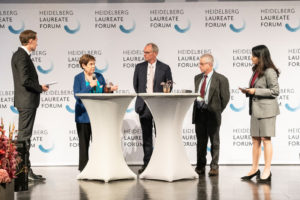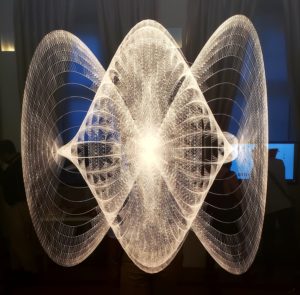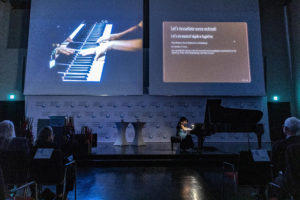HLF 2019 Kicks Off with a Q&A with ACM President Cherri Pancake (plus La La Lab and the Science of Music)


The 7th annual Heidelberg Laureate Forum (HLF) has officially begun! Yesterday (September 21st) was the opening ceremony, which included a “science slam” on the history and founding of HLF from Andreas Reuter, Scientific Chairperson of the Heidelberg Laureate Forum Foundation, as well as a Q&A session with Cherri M. Pancake, President of the Association for Computing Machinery (ACM), Carlos E. Kenig, President of the International Mathematical Union (IMU), and Hans Petter Graver, President of the Norwegian Academy of Science and Letters (DNVA). To top it off the opening ceremony was followed by a reception, giving the young researchers opportunities to mingle with each other and the 23 laureates in mathematics and computer science that are in attendance.
During the Q&A session, Cherri Pancake was asked about the lack of female winners of the ACM A.M. Turing Award (of which only 3 have been female). The Turing Award is one of the awards that qualifies someone to become a Heidelberg Laureate (the other qualifying participants are recipients of the Abel Prize, ACM A.M. Turing Award, ACM Prize in Computing, Fields Medal and Nevanlinna Prize). In response, Dr. Pancake said that ACM is also concerned about this discrepancy but explained that the Turing Award only considers people who have been nominated and unfortunately they see very few female nominees at all. Because of this nomination process, it is up to the computing community to support a greater number of female researchers and nominate them for such awards. (The 2018 Turing Award was awarded to Geoffrey Hinton, Yoshua Bengio, and Yann LeCun for their work in deep neural networks.)
Pancake was also asked if she believes whether all students should be required to take computing courses in school considering the rising prominence of computing in day-to-day life. Pancake said she does believe all students should take at least a few computing courses but not necessarily computer science per se. She noted the kind of computational thinking such classes encourage to arrive at nonlinear, iterative, and/or exponential types of solutions are valuable to everyone. Additionally understanding the notion of complexity with regards to what machines are or are not able to do as it applies to other fields is important to using computers successfully in those other domains.
Dr. Pancake was also asked to explain the difference between the Turing Award and the ACM Prize in Computing: why the two different awards? The answer is the Turing Award recognizes 20-30 years of impact since the original invention, while the ACM Prize in Computing is more for mid-career individuals and focuses on a 10-15 year time frame. Learn more about the 2019 ACM Prize in Computing winner (and CCC Council member) Shwetak Patel here.

Prior to the opening ceremony, I visited the La La Lab an interactive exhibition that demonstrates the relationship between music and mathematics. Developed by Imaginary, a non-profit that supports open and interactive mathematics, the La La Lab features a variety of interactive modules such as a sonogram of different musical instruments frequency compositions and the sound of a Lissajous curve.
La La Lab is currently showing at MAINS in Heidelberg and will be there until Dec 15, 2019. All of the content is available under open license and can be found on Github. You can play with some of the modules on the Show Me the Music or Beat Box webpages.

Continuing on with the connection between mathematics and music, the HLF kick-off ceremony also featured a live piano performance and discussion of the mathematics of music from Charles T. Gray (La Trobe University). In her presentation Gray, a former classical pianist and current doctoral student in statistical meta-research, said that making music is like doing algebra in that both music and algebra are about discovering, recognizing, and exploring patterns. For example, a homomorphism, a structure-preserving map between two algebraic structures of the same type, is analogous to an ostinato, a repeated motif or phrase within a musical composition.
Continuing the comparison, Gray remarked that an ostinato in music is just like a tessellating homomorphism: “each tile (note) is boring on its own but the tapestry (song) of the tiles is interesting.” Always interesting to see the ways that one type of thinking can influence your experience in another domain.

